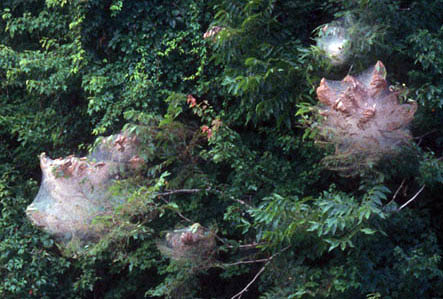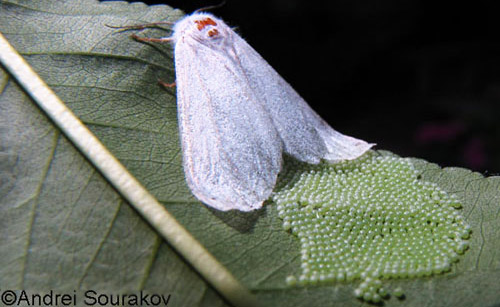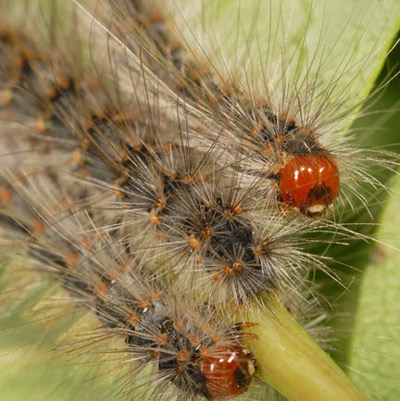Fall Webworm
By Mary Francis, Fairfax Master Gardener Intern

Fall Webworm web
The fall webworm (Hyphantria cunea) is primarily an ornamental pest but can be quite damaging if many webs are present on the same plant. It is native to North America and southern Canada. More than one hundred species of deciduous forest, shade and fruit trees are its hosts. Feeding preferences vary regionally with preferred hosts including mulberry, walnut, hickory, elm, sweetgum, poplar, willow, oak, linden, ash and apple. The caterpillars produce what can be a very large web resembling fine silk which appears only on terminal branches.
Mature female moths deposit up to 900 eggs in hair covered masses on the underside of leaves. The first, small generation begins in May. The eggs are small, yellow or light green. After about seven days, tiny newly hatched larvae form a web around themselves as they feed within the web. As they develop and grow they molt six times which increases the size of the web by filling it with shed skin, droppings and dead leaves. The larger, second generation larvae are present from August through October producing the characteristic web seen in the fall.

Eggs & adult moth
Mature larvae are about 25 to 31 millimeters long with highly variable coloration. Colors range from white to pale yellow or light green. Larvae with black heads are yellowish white, and those with red heads are brown. There can be two lines of black dots down the back. Sometimes there is a black line running down the center back. There is usually a line of yellow spots along both sides of the back. Some larvae are partially or completely dark, with light colored hairs. Larvae with black heads are thought to be more prevalent in northern climes while those with red heads prevail in southern climes.
After four to five weeks, the mature larvae crawl down and pupate in cocoons hidden in mulch, leaf litter or just beneath the soil surface below the host plant. Mature moths emerge during the evening hours. The adult moth has a wingspan of 25 to 31 millimeters. Adults are typically all white in the northern part of its range, while in the southern part of its range the adult is white with spots. Fall webworms overwinter as pupae below the tree.

Red headed caterpillar
The webs may become large and unsightly, but the caterpillars rarely consume enough growth to affect the health of the tree. The webs will persist during the winter months before weathering away.
Fall webworms can be controlled by cutting or pulling the webs out of the tree and destroying the caterpillars. Pole pruners may be useful. There are many species of birds and wasps that keep fall webworm numbers in check. Never try to burn the tents from trees.
The eastern tent caterpillar (Malacosoma americanum) forms nests in the crotches of branches, in contrast to the fall webworm which forms nests on terminal branches. The mimosa webworm (Homadaula anisocentra) attack both mimosa and honeylocust trees. Characteristically, folded brown leaves matted together with webs are seen at the tip of branches.
Resources
Fall Webworm, Steven Frank, James Baker, Stephen Bambara, North Carolina State Extension Publications
Fall Webworm, University of Florida Entomology and Nematology
Fall Webworm, Eric Day, Virginia Cooperative Extension
Fall Webworms, Daniel Frank, West Virginia University Extension
Fall Webworms — Trees, University of Maryland Extension